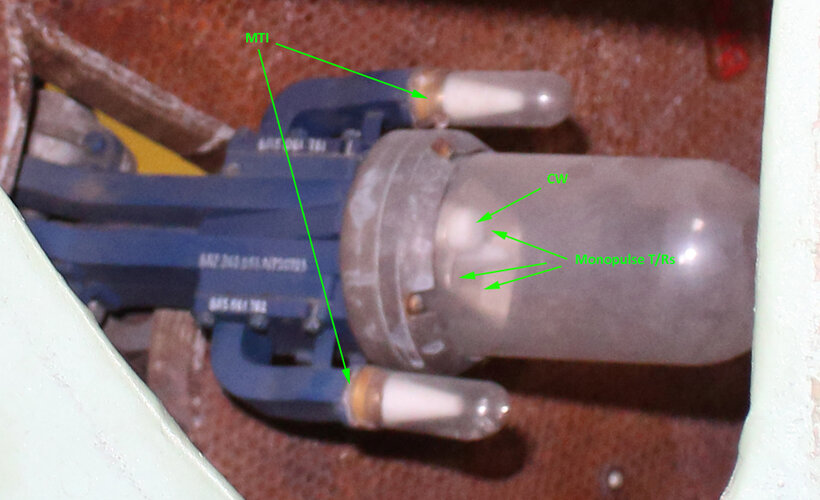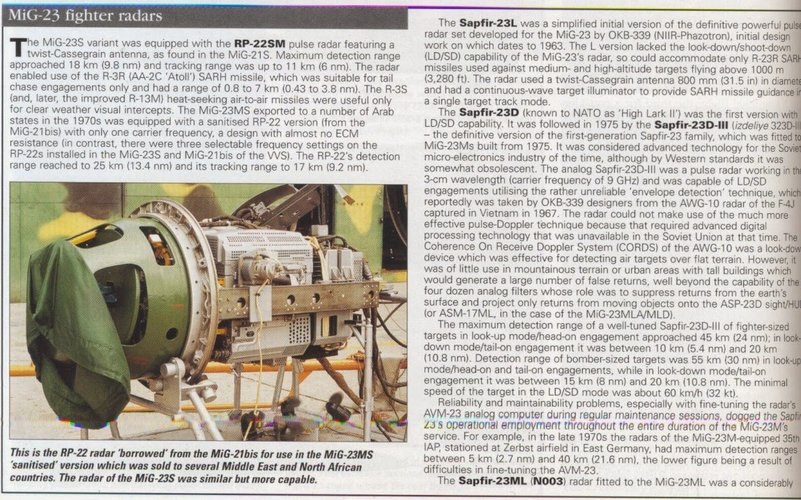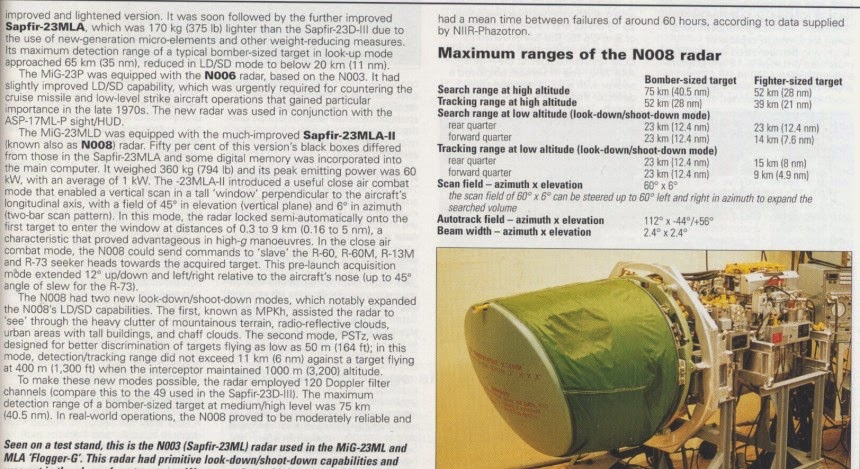Can you give a name of book?The best account of the MiG-23 weapons system development and performance is in a recent MiG-23 book by Viktor Markovsky. I'm translating it at present.
You are using an out of date browser. It may not display this or other websites correctly.
You should upgrade or use an alternative browser.
You should upgrade or use an alternative browser.
Phazotron Sapfir-23 and Sapfir-25 radar
- Thread starter overscan (PaulMM)
- Start date
- Joined
- 27 December 2005
- Messages
- 16,418
- Reaction score
- 18,986
Истребитель МиГ-23 - На защите неба Родины
Viktor Markovsky & Igor Prikhodchenko MiG-23 Fighter - To protect the skies of the Motherland, Eksmo, 2017.
I hope the new edition of Yefim Gordon's MiG-23 book incorporates the materials from this book.
Viktor Markovsky & Igor Prikhodchenko MiG-23 Fighter - To protect the skies of the Motherland, Eksmo, 2017.
I hope the new edition of Yefim Gordon's MiG-23 book incorporates the materials from this book.
- Joined
- 27 December 2005
- Messages
- 16,418
- Reaction score
- 18,986
From a former WarPac radar technician:
I've seen this claim published before but this is the first "evidence" albeit anecdotal
N003E is capable of automatic tracking max 6 aircraft and after pilot launched his R-23R or 24R ,radar is capable of tracking not only engaged target but another 5 in scanning zone ( if there are in that zone of scanning)
I've seen this claim published before but this is the first "evidence" albeit anecdotal
LukaszK
I really should change my personal text
- Joined
- 15 January 2018
- Messages
- 63
- Reaction score
- 74
I saw similar statement regarding Mig-25PD that had very similar radar
6 target "on the pass"
Станция обнаpyживала цели с ЭПР более 10 м2 на pасстоянии 100 км, дальность автоматического сопровождения 75 км, была способна сопровождать на проходе до 6 целей, угол обзора в горизонтальной плоскости +/-56 град., угол обзора в вертикальной плоскости 6 и имела yлyчшенные возможности для обнаpyжения целей на фоне земли.
6 target "on the pass"
Станция обнаpyживала цели с ЭПР более 10 м2 на pасстоянии 100 км, дальность автоматического сопровождения 75 км, была способна сопровождать на проходе до 6 целей, угол обзора в горизонтальной плоскости +/-56 град., угол обзора в вертикальной плоскости 6 и имела yлyчшенные возможности для обнаpyжения целей на фоне земли.
- Joined
- 11 February 2010
- Messages
- 1,448
- Reaction score
- 1,949
kinda difficult to do tho without phased array.
LukaszK
I really should change my personal text
- Joined
- 15 January 2018
- Messages
- 63
- Reaction score
- 74
It is, 'let say' track while scan. The same approach as in Mig-29, Su-27 etc.kinda difficult to do tho without phased array.
It is difficult to do without digital computer onboard. From mid -70tees they used Orbita-20 computers (first used probably on Mig-27K).
Last edited:
Blitzer9856
ACCESS: Restricted
- Joined
- 13 August 2019
- Messages
- 48
- Reaction score
- 66
Does anybody know the range data for the RP-23L? The one fitted to the MiG-23 Edition 1971, the first variant of the RP-23 series.
- Joined
- 27 December 2005
- Messages
- 16,418
- Reaction score
- 18,986
Yes - I have this somewhere, will post tonight. Its a little worse than Sapfir-23D-III at high altitude and more worse at low altitude.Does anybody know the range data for the RP-23L? The one fitted to the MiG-23 Edition 1971, the first variant of the RP-23 series.
- Joined
- 27 December 2005
- Messages
- 16,418
- Reaction score
- 18,986
Sapfir-23L ranges against Tu-16 (16 sq m RCS)
Look up: 35-50km search, 25-35km track
Look down: 8-18km search, 5-15km track
I haven't seen a manual for the Sapfir-23L so these figures are from Russian forum sources.
Look up: 35-50km search, 25-35km track
Look down: 8-18km search, 5-15km track
I haven't seen a manual for the Sapfir-23L so these figures are from Russian forum sources.
- Joined
- 27 December 2005
- Messages
- 16,418
- Reaction score
- 18,986
Renamed topic as all posts were about the Sapfir radar. Added some Sapfir-25 posts.
Blitzer9856
ACCESS: Restricted
- Joined
- 13 August 2019
- Messages
- 48
- Reaction score
- 66
Sapfir-23L ranges against Tu-16 (16 sq m RCS)
Look up: 35-50km search, 25-35km track
Look down: 8-18km search, 5-15km track
I haven't seen a manual for the Sapfir-23L so these figures are from Russian forum sources.
Thanks! Could you link the Russian forum?
- Joined
- 27 December 2005
- Messages
- 16,418
- Reaction score
- 18,986
АВИАЦИОННЫЕ РЛС И ПРИБОРЫ БОРТОВАЯ РАДИЛОКАЦИОННАЯ СТАНЦИЯ Н008Э
Бортовая аппаратура радиоуправления
обеспечивает:
- поиск, обнаружение, опознавание и прицеливание при перехвате воздушной цели в свободном пространстве или на фоне земли, днем и ночью, в простых и сложных метеоусловиях, на встречнопересекающихся и задней полусфере цели;
- формирование необходимых сигналов и команд управления самолетом и выдачу их в систему автоматического управления на этапе самонаведения;
- формирование необходимых сигналов и команд для обеспечения пуска самонаводящихся ракет, а также для обеспечения стрельбы из пушки и неуправляемыми реактивными снарядами;
- подсвет сопровождаемой цели для радиолокационной головки самонаведения;
- индикацию радиолокационной, командно- пилотажной информации и отметок теплопеленгатора на едином совмещенном индикаторе. Режимы работы:
РЛ - атака с автоматическим включением некогерентной обработки или пространственной селекции или селекции движущихся целей в
зависимости от высоты цели иистребителя;
МПХ - атака с селекцией движущихся целей в условиях метеопомех с ручным переключением глубины режекции;
ПСЦ - атака с пространственной селекцией воздушных движущихся целей;
ББ - ближний бой в условиях визуальной видимости;
ГОР - атака в условиях гористой местности.
СОСТАВ:
1. БлокН008- 01 - антенна
2. Блок Н008- 42 - распределитель гетеродинного сигнала
3. Блок С23МЛ- 74А - блок имитации и контроля цели
4. Блок С23МЛ- 12Б - передатчик КНП
5. Блок С23МЛ- 02А - передатчик импульсный
6. Блок С23- 37 - высоковольтный выпрямитель индикации
7. Блок С23МЛ- 65 - блок автоматической регулировки яркости
8. Блок С23- 75 - пульт регулировки яркости
9. Блок С23- 05 - индикатор
10.Блок С23МЛ- 64 - блок управления контролем
11.Блок С23- 50 - комплект антеннофидерного устройства
12.Блок Н008-89А - высокочастотный приемник
13.Блок Н008-40 - комплект монтажный
14.Блок С23- 15 - блок разверток
15.АСП (авиационно-стрелковый прицел, в Н008Э не входит)
16.Блок С23МЛ- 44 - пульт управления средний
17.Блок С23МЛ- 24 - пульт управления левый
18.Контейнер радиоэлектронных блоков Н00810
19.Блок Н008- 94 - блок коммутации
20.Блок H003- 17 - блок питания
21.Блок H003- 27 - блок питаниАВМ
22. Блок H003- 54 - блок сопряжения с КЗА (контрольно- записывающей аппаратурой)
23.Блок Н008- 30 - распределительная коробка питания
24.Блок Н008- 61Э - блок целеуказания
25.Блок С23- 67 - блок терморегулирования
26.Блок С23- 57 - стабилизатор тока индикатора
27.Блок Н008- 34 - пульт управления правый
AVIATION RADAR AND INSTRUMENTS ONBOARD RADAR STATION N008E
Onboard radio control equipment provides:
- search, detection, identification and aiming when intercepting air targets in free space or against the background of the earth, day and night, in simple and difficult meteorological conditions, on opposite intersecting and the rear hemisphere of the target;
- formation of the necessary signals and aircraft control commands and issuing them to the automatic control at the homing stage;
- formation of the necessary signals and commands for starting homing missiles, as well as for ensuring firing from a cannon and unguided rockets;
- highlighting the tracked target for radar homing head;
- radar indication, flight command information and heat direction finder marks on a single combined indicator.
- RL - attack with automatic enabling incoherent processing or spatial selection or selection of moving targets depending on the height of the target and fighter;
- MPH - selection attack moving targets in conditions of meteorological interference with manual switch notch depth;
- PSC - attack with spatial selection of air moving goals;
- BB - close combat in conditions visual visibility;
- MOUNTAIN - attack in mountainous conditions terrain.
STRUCTURE:
- Block N008-01 - antenna
- Block N008-42 - distributor heterodyne signal
- Block S23ML-74А - block of imitation and target control
- Block S23ML-12B - transmitter KNP
- Block S23ML-02A - transmitter impulse
- Block S23-37 - high-voltage indication rectifier
- Block S23ML-65 - block automatic brightness control
- Block S23-75 - control panel brightness
- Block S23-05 - indicator
- Block S23ML-64 - control unit control
- Block S23-50 - antenna feeder kit devices
- Block N008-89А - high-frequency receiver
- Block N008-40 - mounting kit
- Block S23-15 - scanner
- ASP (aviation rifle sight, not included in N008E)
- Block S23ML-44 - control panel middle
- Block S23ML-24 - control panel left
- Container radioelectronic blocks N008-10
- Block N008-94 - switching unit
- Block N003-17 - power supply unit
- Block N003-27 - power supply unit AVM
- Block N003-54 - interface block with KZA (control and recording equipment)
- Block N008-30 - distribution power box
- Block N008-61E - target designation unit
- Block S23-67 - thermal control unit
- Block S23-57 - current stabilizer indicator
- Block N008-34 - control panel right
From
КАТАЛОГ СОВРЕМЕННОГО РОССИЙСКОГО ВООРУЖЕНИЯ
Last edited:
- Joined
- 27 December 2005
- Messages
- 16,418
- Reaction score
- 18,986
Some interesting points in the post above - the RL mode makes life massively easier for the MiG-23 pilot by automatically switching between various lookup/lookdown modes automatically according to the height of the aircraft and target.
Also the block numbering apparently indicates which blocks were replaced for the N008 and which ones were unchanged from N003, Sapfir-23ML and even earlier radars.
It also indirectly confirms Sapfir-23ML is not the same as N003.
15. ASP (aviation rifle sight, not included in N008E)
Interesting, assuming translation is correct...
Also the block numbering apparently indicates which blocks were replaced for the N008 and which ones were unchanged from N003, Sapfir-23ML and even earlier radars.
It also indirectly confirms Sapfir-23ML is not the same as N003.
15. ASP (aviation rifle sight, not included in N008E)
Interesting, assuming translation is correct...
- Joined
- 27 December 2005
- Messages
- 16,418
- Reaction score
- 18,986
Bah, that just means gunsight and I think is referring to the S-17MLD gunsight/HUD.15. ASP (aviation rifle sight, not included in N008E)
Interesting, assuming translation is correct...
LukaszK
I really should change my personal text
- Joined
- 15 January 2018
- Messages
- 63
- Reaction score
- 74
Some interesting points in the post above - the RL mode makes life massively easier for the MiG-23 pilot by automatically switching between various lookup/lookdown modes automatically according to the height of the aircraft and target.
This is somehow known (including antenna elevation) from some old posts related to S-23E and N-003E https://www.secretprojects.co.uk/threads/phazotron-sapfir-23-and-sapfir-25-radar.25/post-60
Comparing to the old posts :
RL - is general purpose mode that switches between modes
MPH - this is doppler mode to reject passive interferences like clouds and chaff, but without (or limited) detection of targets flying on the background of earth, but not limited scanning zone
PSC - spatial selection only - this seems to be not present as separate mode- . Maybe useful for slow flying targets (like helicopters?)
also "mountain" mode is something new.
I am surprised that in N008 did not inherit antenna from the previous versions(s).
Blitzer9856
ACCESS: Restricted
- Joined
- 13 August 2019
- Messages
- 48
- Reaction score
- 66
Is there a manual for the RP-23D-III? If I have to buy it, I will.
- Joined
- 27 December 2005
- Messages
- 16,418
- Reaction score
- 18,986
https://www.secretprojects.co.uk/threads/phazotron-sapfir-23-and-sapfir-25-radar.25/#post-60 has sections from the export S-23E manual.
Blitzer9856
ACCESS: Restricted
- Joined
- 13 August 2019
- Messages
- 48
- Reaction score
- 66
https://www.secretprojects.co.uk/threads/phazotron-sapfir-23-and-sapfir-25-radar.25/#post-60 has sections from the export S-23E manual.
Thanks. But I also need the manual itself in PDF. I'm planning on buying it, but I don't know from where.
- Joined
- 27 December 2005
- Messages
- 16,418
- Reaction score
- 18,986
I don't think you will find a copy for sale anywhere.
The picture of the first post is gone, could you please send it again?Thank youI don't think you will find a copy for sale anywhere.
Last edited by a moderator:
- Joined
- 27 December 2005
- Messages
- 16,418
- Reaction score
- 18,986
I don't have it. The original post linked to a picture long since gone.The picture of the first post s gone, could you please send it again?Thank youI don't think you will find a copy for sale anywhere.
From a former WarPac radar technician:
N003E is capable of automatic tracking max 6 aircraft and after pilot launched his R-23R or 24R, radar is capable of tracking not only engaged target but another 5 in scanning zone (if there are in that zone of scanning)
I've seen this claim published before but this is the first "evidence" albeit anecdotal
Link to this if you don't mind.
- Joined
- 27 December 2005
- Messages
- 16,418
- Reaction score
- 18,986
It was a private email. Quote is exactly as he said it.From a former WarPac radar technician:
N003E is capable of automatic tracking max 6 aircraft and after pilot launched his R-23R or 24R, radar is capable of tracking not only engaged target but another 5 in scanning zone (if there are in that zone of scanning)
I've seen this claim published before but this is the first "evidence" albeit anecdotal
Link to this if you don't mind.
Is a copy of this manual available somwhere?Hi Gorka,
You can find the details you require in this same thread, page 1, the details are from MiG-23ML's weapon systems manual as provided by the user Mr. Detonator, nearly 10 years ago.
The weapon system selector switch “SIST” with modes:
-RL (BSV, BSV - Delta H4, BSV - Delta H1, SMV, MV)
-BS (I BS, II BS, III BS)
-T (T I, T II, T III, T – Phi 0-I, T – Phi 0-II)
-NVG
The switch IZL-EKV-VYK, impulse transmitter (emit/equivalent/off)
The switch NAVED-AVT-RUCHN, the GCI datalink ARL-SML on/off
The switch MSKC-PPS-ZPS, low-speed target engagements/front/rear hemisphere
The switch PU-VYK, parametric amplifier ON-OFF
The modes BSV, BSV-delta H4, BSV-delta H1, SMV, MV are switched automatically according to aircraft altitude Hs (DV-30 barometric sensor) and the antenna position ”Delta H” switch. The modes I BS, II BS, III BS must be switched manually. When the switch NAVED AVT/RUCHN is set to AVT, the radar mode selection is done automatically by GCI command link (ARL-SML). The radar scan patterns under GCI are better optimized due to PPS/ZPS aspect. The one-way commands from GCI are displayed on special symbol indicator on the HUD sight. Pilot can interrupt the GCI anytime setting the switch to RUCHN.
The mode BSV for high/medium altitudes, all-aspect intercepts (Hc<>=Hs), pulse width ~4 µsec, PRF 1Khz, switching altitude Hs>4,5km, Beam width in search 2,5°. Scan patters depend on NAVED AVT/RUCH switch position. Beam width in STT 1.7°.
The modes BSV-delta H4, BSV-delta H1 for high/medium altitudes are useful for searching targets on earth background not using the Doppler shifts (MTI). For all-aspect intercepts, switching altitude is 4.5km>Hs>1,5km. It uses half/third PRF compared to BSV mode. The “differential compensator device” (DKP) filters false ground signals out. For greater search range the parametric amplifier can be switched on. The receiver sensitivity gains of 5-10% (dB/mW).
The modes BS (I BS, II BS, III BS) for high/medium altitudes are used for all-aspect intercepts (Hs<>=Hc) in case of false targets (clouds) and for picking up targets on earth background by using reference coherent signal received by radar side-lobes. The “III BS” mode has the largest search range of 65km, the “I BS” the smallest one of 27km. The most used mode is the “II BS” with 45km search range. The "III BS" mode works only as a search mode. The FFT Doppler filtering techniques are used to select moving targets flying on the earth background. The so-called “blind speeds” are overcome by changing PRF pulses during each scan line. More than 90% of “blind speeds” are covered, what ensures good MTI.
The mode SMV for medium/low altitudes, only rear-aspect intercepts (Hs<Hc), The switching altitude is Hs<1.5km, pulse width ~1 µsec, PRF 1Khz. The scan patters depend on NAVED AVT/RUCH switch position.
The mode MV is used to engage targets flying at low altitudes on the earth background. It is only for rear-aspect intercepts (Hs>Hc), The switching altitude Hs<1.5km, switch “Delta H”<0, pulse width ~1 µsec, Beam width in search 2,5°. The MV mode uses the MTI based on Doppler shifts.
Do you recommend the afore-mentioned book?
Hungarian MiG-23MF Sapfir-23D radar at the Szolnok RepTár museum.

It has a central transmitter, incorporating 4 monopulse receiver box, and a CW transmitter for the R-23R missile.
There is two horn receivers to source the ground reflection frequency for the MTI system.
You can also see the compensation receiver. (yellow waveguide at the top)

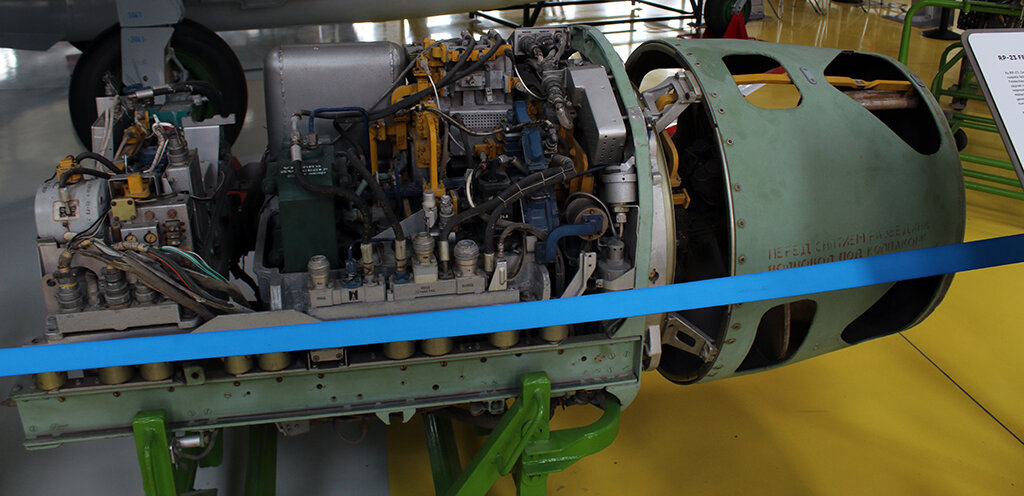
It has a central transmitter, incorporating 4 monopulse receiver box, and a CW transmitter for the R-23R missile.
There is two horn receivers to source the ground reflection frequency for the MTI system.
You can also see the compensation receiver. (yellow waveguide at the top)
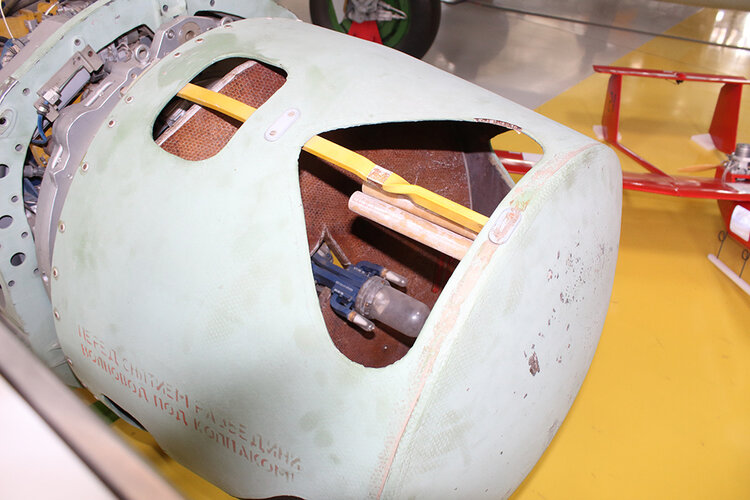
Last edited:
- Joined
- 11 February 2010
- Messages
- 1,448
- Reaction score
- 1,949
Some description on "Externally coherent" system from "Handbook of Radar Engineering Fundamentals" 1967 Edition. Basically why Soviet called it Coherent. Their "definition" of coherent transmission is based on the presence of reference signal, as long as there is reference signal regardless of source, it would be considered Coherent. The "Western" definition of coherence tho in this literature is referred as "Internally Coherent" as the source of the reference signal are within the radar.

The literature is downloadable for free in NTRL as "AD716660"
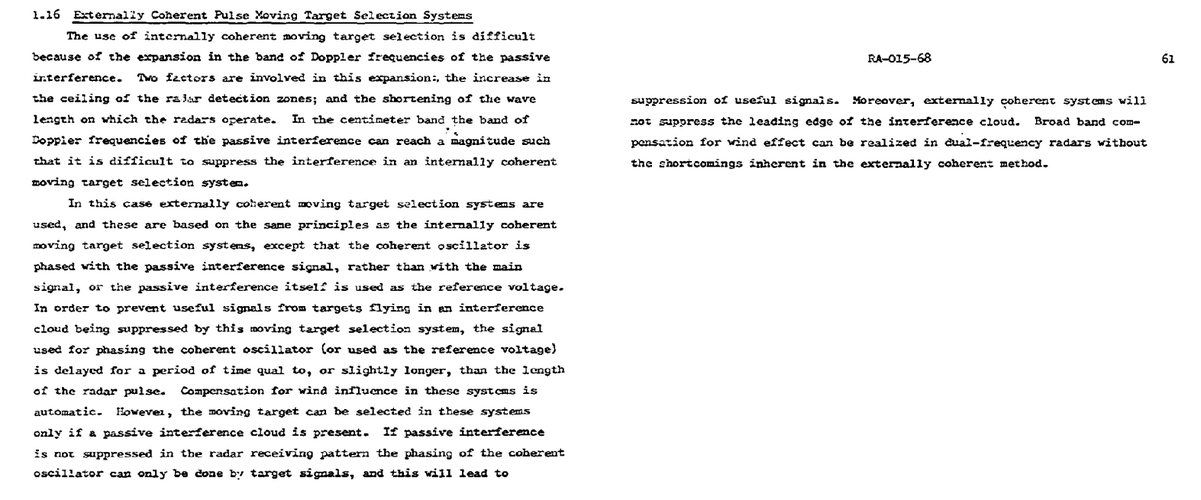
The literature is downloadable for free in NTRL as "AD716660"
LukaszK
I really should change my personal text
- Joined
- 15 January 2018
- Messages
- 63
- Reaction score
- 74
Very interesting. In other word, "external coherence" is nothing more that "internal coherence" - except how COHO oscillator is initialized. And this is not due to some limitation of technology. Rather to cope with strong reflections from the ground...Some description on "Externally coherent" system from "Handbook of Radar Engineering Fundamentals" 1967 Edition. Basically why Soviet called it Coherent. Their "definition" of coherent transmission is based on the presence of reference signal, as long as there is reference signal regardless of source, it would be considered Coherent. The "Western" definition of coherence tho in this literature is referred as "Internally Coherent" as the source of the reference signal are within the radar.
The literature is downloadable for free in NTRL as "AD716660"
Very interesting, some details, and ranges provided.
However "external coherence" method might not be spotted on F-4J from 67 (was there any such version in US Navy, operational that time??)
Navy fighters - had true pulse - doppler radars that time, however not best suited to work over land, all aspect...
It might be F-4E , in which, there was such attempt to make LD/SD - however - practically not working (even less than on Mig-23M).
And despite similarities... I think that development for Mig was not (or minimally) influenced by US designs... (as it was developed much before 67...
(And I am not 100% sure but Sapphire's frequency was probably higher - closer to 12GHz )
And one more limitation of such design (Low - PRF, coho on receive ...at least in "internal" coho).
1. As coherence signal (generator) is initialized with transmitting pulse, it has preserved phase of the LAST emitted pulse.
(Emitted pulses are not coherent!)
So coherence is "valid" within the ("first") unambiguous range. So for example with repetition frequency PRF = 4kHz unambiguous range is 37,5km (300 000 km / PRF / 2).
2. On the other hand: in frequency (Doppler) space the distance - between spectra repeats - is PRF
Doppler return from main lobe (depending on antenna angle, and its beam width) might be more than +/- 1kHz. This leave you only 2kHz "free space" to see between return(s) from the main lobe(s) (ground).
So designer would like to increase PRF. But it can not, unlimitedly - as it decreases unambiguous ("parametric") range.
(Note : This is true for "internal coherence". But probably is also true for "external" - as reference is (initialized) by stronger return from closer range "unambiguous" - not from the second...)
And you can see ranges for look down mode for N008 - they are limited to 23km ... this limitation comes from PRF and it is hard limit.. even if target has strong return ("bomber size").
And such limit (hard range limit) does not exist in truly coherent, Med PRF (PRF 8kHz or more ).. as all emitted pulses has the same coherent phase... so you can take returns from the first unambiguous range, but alos second , third ... and so on..
In MED PRF there is also no limitation on deflection angle - how much you can point your antenna from axis...
A width (in Doppler space, its ground return) of main lobe depends on how sideward antenna is pointed.
If you point much to side... width of ground is high.
In low PRF distance between ground returns is low... so you have to keep you scanning angles low. In other case - ground returns in Doppler space will take significant portion of Doppler space.. not leaving space to see moving returns between them.
This effectively limits, usable angles. In case Sapphire it was said only to +/-30 degrees..(see past post in this topic)
Again - such limitation does not exist on Med PRF... still width of ground return in Doppler widen ... but with 8 or 16kHz it does not matter significantly .
- Joined
- 27 December 2005
- Messages
- 16,418
- Reaction score
- 18,986
Get reading, lots of juicy Sapfir-25 details in the MiG-25PD Flight and Combat Employment Training manual in English (for Iraq).
HERE
I did the OCR, file posted by https://aviationarchives.blogspot.com
HERE
I did the OCR, file posted by https://aviationarchives.blogspot.com
LukaszK
I really should change my personal text
- Joined
- 15 January 2018
- Messages
- 63
- Reaction score
- 74
Just quick replay, few words.Get reading, lots of juicy Sapfir-25 details in the MiG-25PD Flight and Combat Employment Training manual in English (for Iraq).
HERE
I did the OCR, file posted by https://aviationarchives.blogspot.com
First of all - great finding Overscan!
As this is for export customer, always in any literature it was said, that Iraq and other countries got version PD , PDS but with older radar I mean Smierch-A2 or something. If this manual was indeed used by Iraq, this is not true.
This radar is for sure "post Bielenko" updated version with "doppler" modes.
Some quick observations:
Radar ranges, for look - up cases, are not so spectacular , depends on altitude of targets and fighter, but generally in line what was known before.
"Known before" 110km for Tu-16 is rather the most optimistic ideal case (higher possible limits against the background of clear sky), rather than standard range.
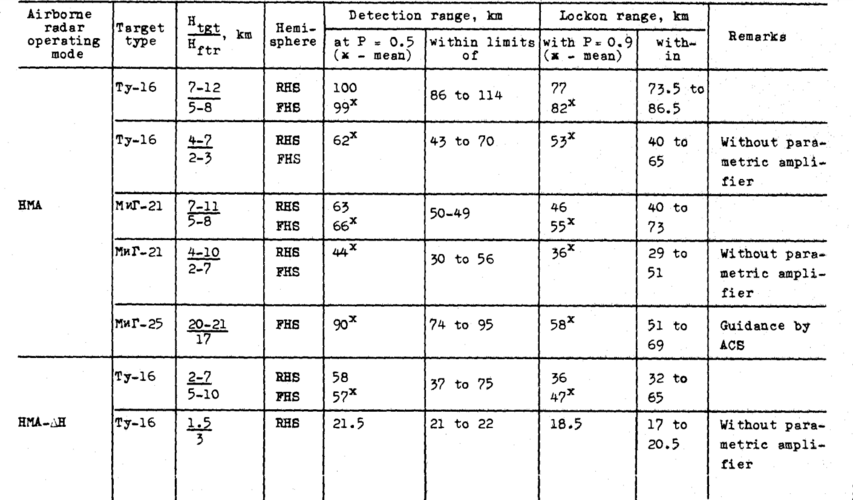

Down look ranges (doppler mode) - not so bad. But for most cases - there are listed from rear hemisphere.
What is interesting is quite long range for slow flying target (Mi-8)
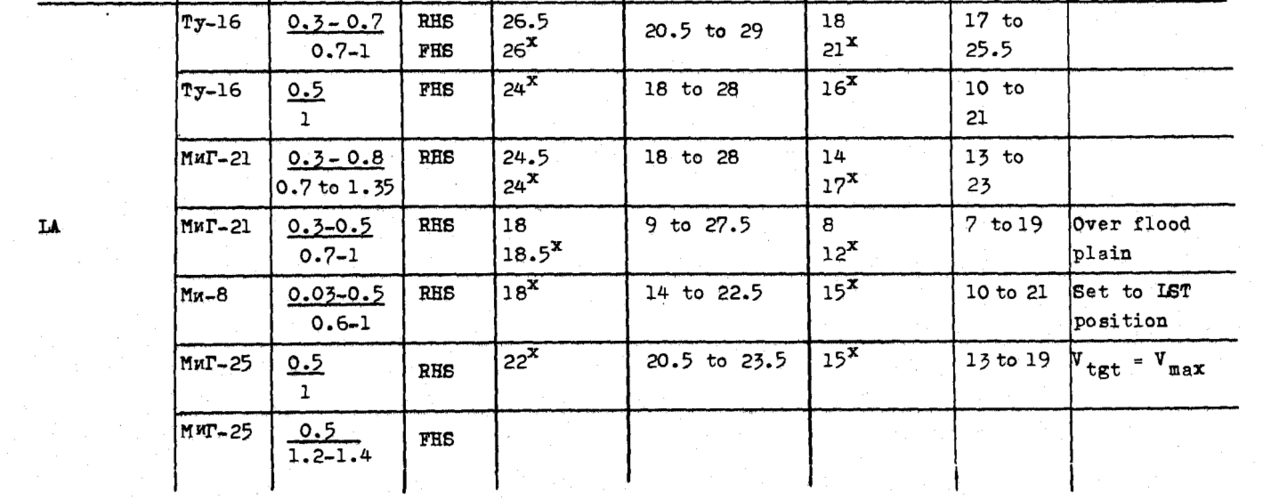
All modes and ranges - are consistent with what was known before, and with data and modes from Mig-23.
What is worth to notice that "doppler mode" works only when plane (I mean Mig-25), fly on low altitude - some below 1.5 - 1 km. This mode seems to not work on higher altitude.. There seems to not be "high flying Mig" searching and hunting for very low flying targets...
Comparing to the later design... it is obvious how much progress was made (I mean Su-27 which has radar in size and weight is in class to Saphir-25.. range is 70...100km / forward ( 40 - 50 rear hemisphere) almost irrelevant to target height ... and for Mig-25 - this is (Taking as target Mig-21) this is somehow between 40 - 60km for high altitudes, and under 20 for low...
Way of working (for example directing zone of search, how plane is directed, how programs of interceptions works, how data links works, general approach) - this looks very similar to the later designs (I mean instructions from Mig-29 and Su-27). Even screen - philosophy , with big circle and small circles - looks similar. Of course in later designs are done with much more modern way (vector graphics instead some analog "lights"), but conceptually way of working... very similar.
It can now be i guess confirmed that the MiG-25PD that shot down Speicher's F-18 had a Sapfir-25, not a Smerch like some claim. It is also very likely Syria, Algeria and Libya got the Sapfir-25 with their upgrades MiG-25PDs.
LukaszK, have you come across the weight of the Sapfir-25? I skimmed through the manual but unless i missed it, i coudn't see such info.
LukaszK, have you come across the weight of the Sapfir-25? I skimmed through the manual but unless i missed it, i coudn't see such info.
- Joined
- 27 December 2005
- Messages
- 16,418
- Reaction score
- 18,986
I wouldn't necessarily generalise from Iraq getting Sapfir-25 to, say, Libya getting it.
- Joined
- 27 December 2005
- Messages
- 16,418
- Reaction score
- 18,986
In general the description of the Sapfir-25 radar modes etc are most consistent with the N008, though lacking the close combat mode I think.
Some of libyan MiG-25PD have the KDS-155, SPO-15 RWR and the TP-26Sh just like the upgraded iraqi or syrian ones, it seems very unlikely they retained the Smerch, particularly since Libya got the export MiG-23MLDs around that time.
Keener eyes might perhaps notice the slightly longer nose and different nose panelling in pictures that are as i understand the differences compared to a normal P.
Keener eyes might perhaps notice the slightly longer nose and different nose panelling in pictures that are as i understand the differences compared to a normal P.
- Joined
- 27 December 2005
- Messages
- 16,418
- Reaction score
- 18,986
Well, yes, but the timings of such are uncertain. Post USSR, lots of stuff got sold, spare airframes transferred. I'm talking about MiG-25PD deliveries in the USSR era. It seems the PDS indeed existed and had the Smerch, but who got MiG-25PDS versus MiG-25PD and when is still to be determined.
Genuinely curious of any evidence of PDS with Smerch. To me PDS is the designation of basic P (either domestic or export) upgraded with the Sapfir-25 and TP-26 etc (as opposed to the new built PD with same radar). Sort of like MiG-31B and BS where the first is new built while the second is in-service airframes upgraded to B standard.
Btw the only country who got MiG-25PD in the nineties is Algeria who got second hand ukrainian ones iirc (but without SPO-15 and KDS-155), likely in exchange for their MiG-25P.
Btw the only country who got MiG-25PD in the nineties is Algeria who got second hand ukrainian ones iirc (but without SPO-15 and KDS-155), likely in exchange for their MiG-25P.
- Joined
- 27 December 2005
- Messages
- 16,418
- Reaction score
- 18,986
IIRC it's explicitly said in the Marmain/Belyakov MiG book that the export MiG-25PD version combined the longer nose of the -PD with the Smerch radar of the -P. That's where this idea comes from. There is no mention of an export version with Sapfir-25.
You are correct about the PDS being remanufactured Ps.
You are correct about the PDS being remanufactured Ps.
Last edited:
Similar threads
-
K-25: Soviet Sparrow clone
- Started by overscan (PaulMM)
- Replies: 47
-
Phazotron AESA radar
- Started by overscan (PaulMM)
- Replies: 9
-
Phazotron NIIR Zhuk radar family
- Started by overscan (PaulMM)
- Replies: 23
-
-

